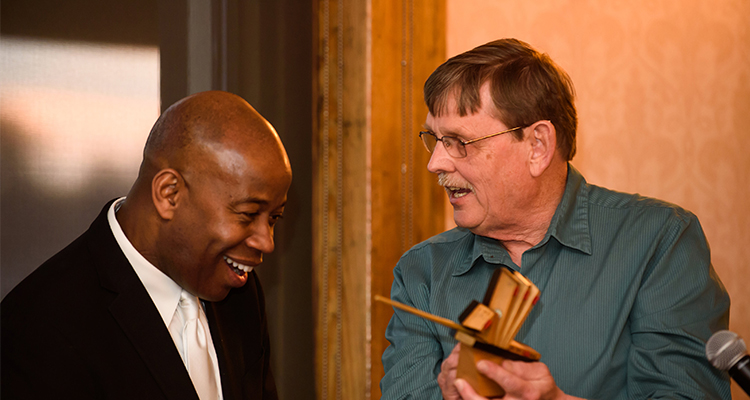Like a vocalist warming up his voice or a pianist limbering her fingers, artist Eric Dye warms up with quick sketches and paintings to get his creative juices flowing.
And those creative juices have been flowing into musical works of art since last September when he took on the task of making eight pieces that embody this season’s Wheeling Symphony Orchestra concert programs, plus a special one for Maestro Andre Raphel.
Each piece is an artistic rendering of the concert’s musical program. Each piece incorporates piano keys or other parts in tune with the symphony’s 88th season — 88 years, 88 piano keys. Each piece — a labor of love — found a home with a concert sponsor.
While Dye figures he spent about 60-80 hours a week since September on the nine works of art — with the exception of one week when he moved from Moundsville to Bethlehem — he only had about four days to complete the first one.
It all started when Gail Looney, WSO development director, queried local artists to create thank-you art for the concert sponsors.
“After attending a conference with the West Virginia Division of Culture and History that included West Virginia artists as well as musicians, I decided to seek art from Artworks Around Town. 2017-18 was our 88th season, which gave the perfect opportunity to focus on 88 piano keys,” Looney said.
Dye responded to Looney’s query. He was most interested in creating the piece for the “Appalachian Rhapsody” concert featuring Wheeling pianist/composer Nathan Strasser.
“He gave me two sketches for sculptures, which were ‘Appalachian Rhapsody’ and ‘Bach Double,’ which were terrific,” Looney said. Just a few days prior to the first concert, Dye decided to create art for all the concerts. “And we were thrilled,” she said. Wheeling artist Bob Villamagna and one of his students also created a couple of pieces, Looney noted.
“When I was convinced that the piano keys I had purchased on eBay from a vintage piano would not work for art, Eric always surprised and delighted us with his talent. He made the musical concepts of each concert come alive through his work. And the piano keys became such an important part of each work that this project could not have worked without his creativity. We are so appreciative of Eric’s talent and his work ethic! BRAVO!” Looney said.
Dye said he gets bored quickly with any one medium, and often bounces from one to another, so using paint combined with his high-end printer, creating three-dimensional pieces, and working with wood, piano keys and glass have all been quite exciting for the artist.
“It’s been a new challenge for everyone. I’ve gotten to play with a lot of different mediums while doing it,” he said. And he did it all in exchange for just two season tickets.
“It’s all been a great experience,” he said, and proceeded to explain his artistic thought process and research in stunning detail.
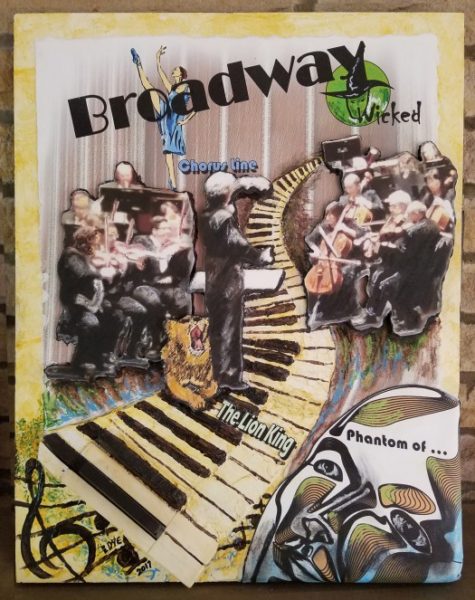
“BLOCKBUSTER BROADWAY” (Sponsor: Jonathan and Jessica Bedway)
The first piece was part digital and part paint, he explained. His high-end Giclee printer, which makes museum-quality prints, provided the background of this piece. He incorporated photos of the symphony and some Broadway tunes that were to be performed.
“My wife, who is a piano teacher and lived in Hackensack (N.J.) and went to the symphony in New York, told me that Broadway meant the ‘Great White Way.’ So I took that idea and made the keyboard like a highway going back through the orchestra and then put in the tunes they were playing.”
The first three keys on the “highway” are real piano keys, and the rest are painted on the background, he explained. “Then, the ‘Phantom’ raises up — partly digital, partly paint. There are nods to “Wicked,” “The Lion King,” “Chorus Line,” too.
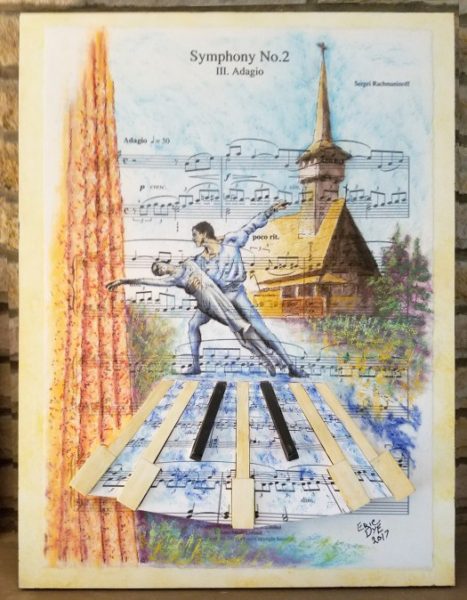
“RUSSIAN MASTERPIECES” (Sponsor: Pete Holloway)
The Adagio movement of Rachmaninoff’s Symphony No. 2 reminded Dye of the Bolshoi Ballet, and he created a piece in which the subjects practically dance off the canvas.
“I created two Bolshoi dancers, male and female, and I put them on a stage. The stage actually tilts out … the stage is made out of piano keys.
“I actually cut my thumb with a table saw when cutting them out,” he shared.
“Again, I used my high-end digital printer and printed the first page of the adagio movement. … Then I painted over top of it so that you had the music score coming out from behind it. The church is a Russian Orthodox church that I photographed in Romania years ago. I went there on a mission trip. … Then I went online and looked at the theater where the Bolshoi perform, and they had this beautiful, heavy gold curtain on the stage. … and I emulated that on the side to add an extra dimension to the piece.”
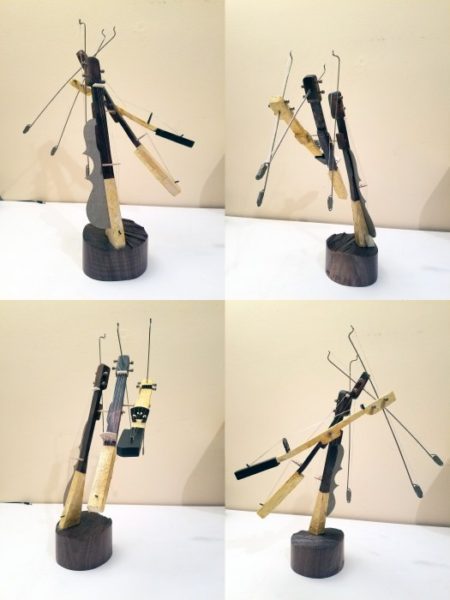
“BACH DOUBLE AND MOZART” (Sponsor: Elizabeth Stifel Kline Foundation)
Welding material, cow bone, banjo strings, lead weights, and piano pins and keys went into a sculpture with motion for the Bach Double and Mozart program.
“Here I wanted to do something different … more sculptural. So I took three piano keys, two white ones and a black one, and I made little violins out of them. I had to order the smallest size violin bridge and put a pin on it and counterweighted it; I had to drill into the base and figure out how many lead weights to put it in there to give it the balance I wanted. Up at the top, I took a piece of bone [cow] … and that made the nut. Then I used the pins that you find at the end of the keys and used as the tuning pegs. I bought the lightest weight banjo strings I could buy for strings, and in theory, they could be tuned,” he said.
He used brazing rods and strings to make a bow, and lead weights for balance. Brazing rods, he explained, are what a welder might use to “glue” two pieces of metal together. Brazing is similar to soldering.
Dye was offered $3,700 by someone in Tennessee for this work, but he turned it down. “I did it for the symphony … I’ll never duplicate anything I’ve done here for the symphony.
“Up to this point, it was my favorite. Actually, as I did each one, I liked each one better. But, I also had more time. The first one was really rushed. And then I had three weeks to do the second one, and I had four and a half to five weeks to do this one. … It’s taken up almost all my time.”
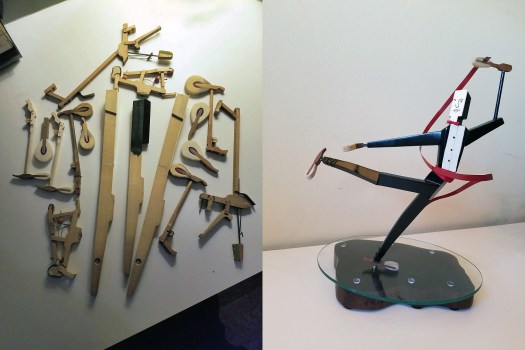
“SYMPHONY ON ICE” (Sponsor: Paul Tucker)
A cubist-looking figure skater who appears to spin on ice was the end result of this piece that started out with three piano keys and some action parts.
“I used the hammers to create hands and skates. In this one, I had to cut it apart in pieces and reassemble it in order to the get the human figure. I had to calculate proportions and length and balance, and I wanted it to have sort of a cubistic look. If you look at the face, it has very much a cubistic face. I had a piece of glass custom cut to set on a walnut base to give it a feeling of being on ice. To give it a feel of motion … I took a thin piece of metal and cut it, filed, shaped it, painted it to make it look like a ribbon flowing around the skater as he spun around.”
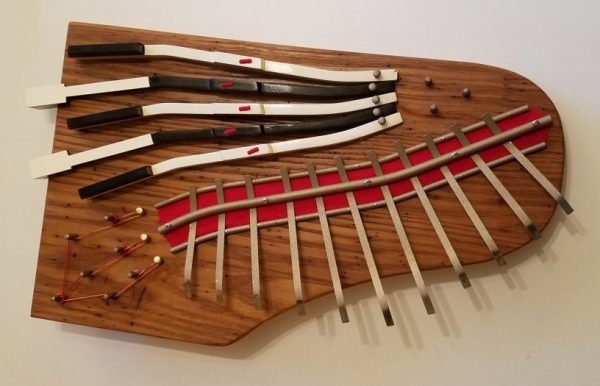
“BACK to BACK: THE MUSIC OF ELTON JOHN AND BILLY JOEL” (Sponsor: WesBanco)
Dye described this undertaking as “a little bit of a puzzle.” … but he solved it, just in “tine.”
“I like classical music but I’m not up to date on current music. … And I didn’t realize Billy Joel was a classically trained pianist. So I had to do a lot of research on both of them. How then do I take Elton John with his flash and flare, and Billy Joel with his more laid-back and relaxed look, and put them together in a piece?
“And I really wanted to do something that was musical in itself, so what I came up with was this … it’s shaped basically like a grand piano. … And I took five piano keys and altered them, in that I left the white part white but everything else I made black. … And the black key, I left black, and made everything else white … so they alternated back and forth. And I fanned them out … Elton’s John’s music is so expansive; he covers such a large range of music styles … I fanned them out to give the feeling of music expanding. And then I took an old rake, and I cut off the tines … , and I put them together to make a thumb piano, which is roughly tuned. … I put that going in the opposite direction, staying with the ‘Back to Back’ theme.”
It sits on a piece of 150-year-old wormy chestnut that came from old shelves he salvaged from a courthouse attic in Pocahontas County, W.Va.
The “Back to Back” piece is on display at WesBanco, and people pluck it as they walk by, he’s been told.
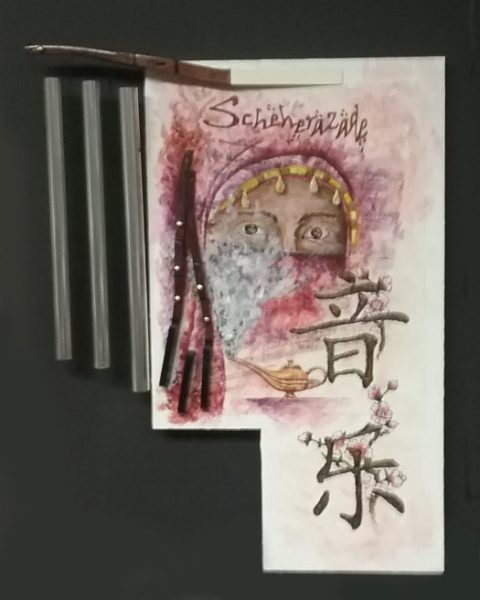
“EAST MEETS WEST” (Sponsor: Lou and Charlotte Kourey)
This concert was comprised of Chinese composer Tan Dun’s Symphonic Poem of Three Notes and Rimsky-Korsakov’s Scheherazade … “What do you do with that? I really struggled. I listened to Tan Dun multiple times. I listened to the Scheherazade multiple times. And I could sense the feeling of the storyteller in the Scheherazade, and then the uniqueness of the Three Note Tone Poem of Tan Dun, and I couldn’t let either one of them go, so I had to find a way to bridge the two.
“So what I did, I got a wind chime, and I toned the three chimes to Tan Dun’s Three Note Tone Poem. So those are toned to the actual poem. And I wanted to sort of bring out the Chinese character, I went to my Chinese friends and learned how to write music in Chinese. And I then painted it on there, to have the texture of the cherry blossom stems, as if the lettering was actually made out of cherry blossom stems.”
He also included a lamp and the veiled storyteller from Scheherazade. The music of Scheherazade is flowing through there as well, which he printed on his Giclee.
“The three piano keys I used as part of her veil coming down and studded it with the pins as though it was jewelry in her hair or in her veil.”
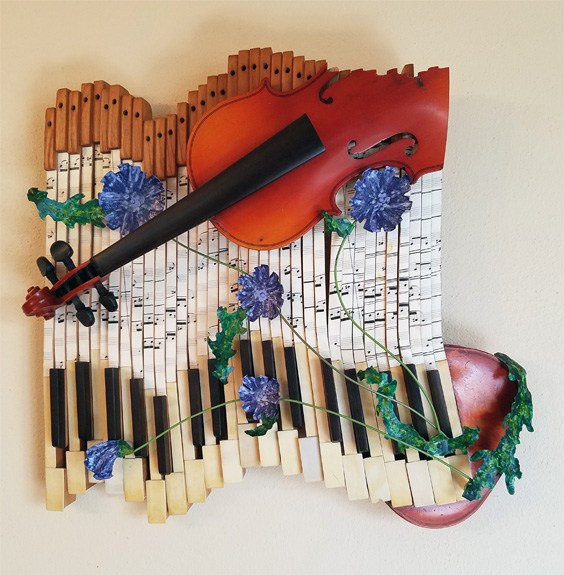
“APPALACHIAN RHAPSODY” (Sponsor: Rosalie Dlesk)
“This is the one that started it all,” he said.
“I listened to the music, and I have played — poorly — but played traditional folk music in the past on a dulcimer and grew up listening to folk music at folk festivals, so when I heard this piece … and heard all the traditional sounds in it, I fell in love with it.
“I could hear the rolling mountains in it. I could hear the movement of the traditional folk music in it, so I wanted the piano keys to go forward and back, and up and down, like the mountains, and have that rolling, moving feel of the music and the mountains of the Appalachians. And then, I also wanted the music on it, so I got Gail to give me a copy of the score of the music and enlarged it on my printer, just a small portion of it that had the melody.”
He then put the music on the keys, which he joined together with screws.
“Since it was written for piano and violin, Gail got me an old violin that was in pieces. I rebuilt it … then I cut it apart … (my wife just cringed!) … in order to put part of it coming out from behind, and the other part laying over the top, and I cut the top of it to create the feel of the mountain ridges,” he said.
“Then, because chicory is such a common wildflower throughout the Appalachians, I took aluminum and cut out and hand-hammered to create the texture and the shape of chicory flowers and the leaves. Then I used brazing rod to create the stems, and I painted it all and put it on there, on posts so that it would stand up above and give it the shadow. One of the things about sculpture it has to have shadow to work, and so everything that was done in all of these three-dimensional pieces was done with the idea of shadow in mind.”
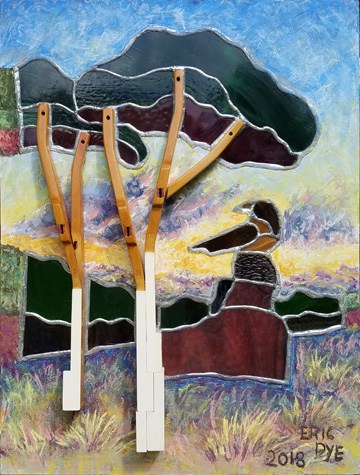
“SEASON FINALE: RESPIGHI’S PINES of ROME” (Sponsor: Lynne and Ben Exley IV)
The last piece is Respighi’s “The Pines of Rome” — which he finished a couple of days ago, just before the final concert of the season, set for Friday, May 19.
“Now those pines are not pines like we think of here. … They come up with this long stem that branches out and then have this canopy up with very little down below or nothing down below. I had to figure out a new way to think about pine trees. Then I listened to Respighi’s piece, and I remembered I had it on an old LP record. The [third] movement is a night scene where he actually went out and recorded a nightingale… . Now I have two thoughts. I have the nightingale, and I have the pines. So what I’ve done, I have created in stained-glass a nightingale on a rock wall. And the foliage from the pines above it, and then I’ve made the tree trunk out of piano keys. … I actually took a canvas board … and I embedded them [the stained-glass pieces] into the canvas board, so it can hang on a window and have light come through it. It is a stained-glass window on its own. But on the surface of the canvas board that’s left, I will be painting a sunset scene as it’s coming up on twilight, and the nightingale is just coming out to sing.”
He learned a new artistic skill with this piece.
“Now, I had never done stained-glass work before. I had to research it. Fortunately, my daughter is a stained-glass artist. So I went back to her to get advice, and she told me how to do it.”
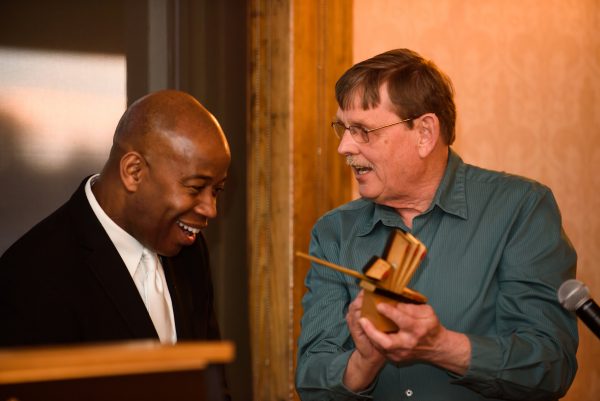
WSO LOGO PIECE
Raphel will be leaving his tenure as music director of the Wheeling Symphony, after 15 seasons, so Dye created a piece to commemorate the conductor’s time here.
“I wanted to stay with the piano keys. … Knowing that conductors tend to live minimalist lives and travel, I didn’t want something that would be too bulky … actually, my wife Christine suggested I do the logo. … It was a perfect fit. … something that would be a remembrance of his time here with Wheeling Symphony and be a remembrance of this 88th season and all the pieces with piano keys.”
WILL THE ADVENTURE CONTINUE?
He started out with about 55 piano keys and some action parts, and all he has left are a few scraps.
“It has been a great adventure. I’ve thoroughly enjoyed it. I’ve thoroughly enjoyed the music.”
And Dye already is looking to the future.
For the 90th anniversary season, “I’d like to do one large piece that is both a carving and a painting, with embedded glass in it. I have a large piece of walnut that’s 2 1/2-feet wide and 4-feet tall and 4-inches thick, that I would like to do a relief carving in and have cutout openings, and in some of the openings embed glass to let light come through, and utilize whatever theme the symphony comes up with. The idea would be to have it at the first symphony, available to be viewed all season long and let people do a silent auction for it, and let that be the fundraiser where I’m not scrambling every month to do a new piece and a new idea.”
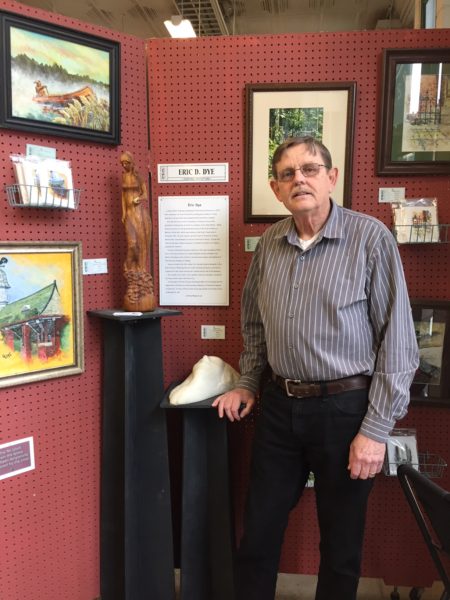
THE ARTIST: “Painter, Sculptor, Teacher, Artistic Storyteller”
A native West Virginian, Dye spent part of his teen years living in East Africa, studying at a British military boarding school with students from 27 nations. He described it as “culture shock” coming from southern West Virginia, but it was quite a learning experience.
“It opened my eyes to a lot of things,” he said, and he sees a lot of influence in his work from those two and a half years.
He’s been interested in art since the age of 4 or 5, he said, when he started drawing on blank newsprint that was wrapped around the newspapers delivered to his house. He went to the encyclopedia pages full of colorful birds and replicated them. He also drew lots of hands, he said. “They were right there. I could look at it and draw it.”
He graduated from Concord University in 1974 with a bachelor’s degree in fine arts, served as an artist-in-residence in Harpers Ferry and also at Concord University.
Later, he studied at the Lyme Academy of Fine Art in Old Lyme, Conn., with Elisabeth Gordon Chandler and Robert Brackman. Brackman, Dye said, studied with Monet.
He is a member of Artworks Around Town, participates in art shows and Paint Historic Wheeling plein air paint out, and he offers private and group art lessons. You can see more of his work at ericdyeartstudio.com.
• After nearly 38 years as reporter, bureau chief, lifestyles editor and managing editor at The Times Leader, and design editor at The Intelligencer and Wheeling News-Register, Phyllis Sigal has joined Weelunk as managing editor. She lives in Wheeling with her husband Bruce Wheeler. Along with their two children, son-in-law and two grandchildren, food, wine, travel, theater and music are close to their hearts.


